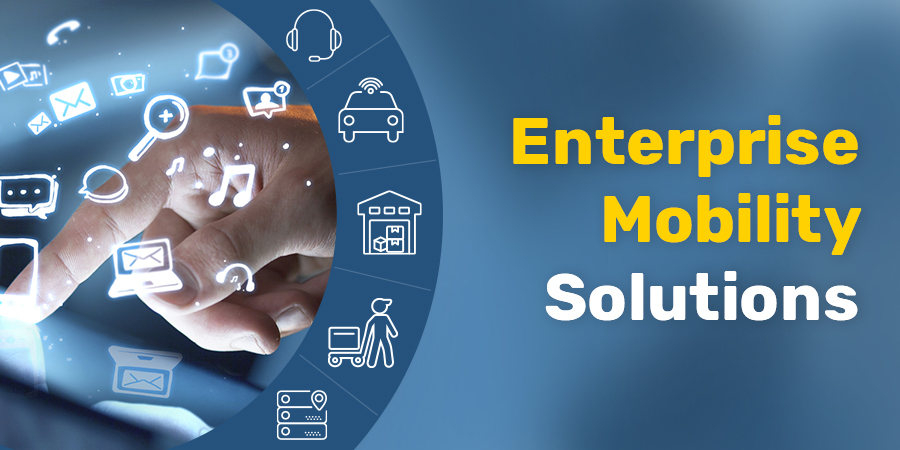Over the years, the meaning of mobility for businesses has changed phenomenally. Initially, mobile apps were consumer-oriented, built with the purpose of connecting with the customers and selling products and services to them. However, as organizations grew in size and complexity of operations, these apps evolved and took the form of enterprise mobility solutions. In fact, these apps that are specifically meant for the internal use of employees, partners, and clients, have become a necessity rather than choice for enterprise-grade businesses. Undoubtedly, the benefits of these apps are extensive and unless businesses are willing and able to take this initiative, they may lack behind the competition and lose their market share.
Investing these applications goes much beyond conventional mobile app development approach as businesses need to have solutions that are worth the effort and investment. The initiative has to be a comprehensive one, covering aspects like enterprise mobile applications, mobile device management, manpower mobility initiatives, and more. Before you take the next step on the mobility front, you need to understand the best practices that you need to adhere to. Let us try to understand what lies ahead in the future for businesses that have an enterprise mobility in pipeline.
Enterprise mobility practices for the future
As BYOD (Bring Your Own Device) concept experiences widespread adoption, mobility becomes the mainstay of digital transformation for enterprises. Despite the fact that employees are getting access to the organizational data on their mobile devices, only a few businesses follow the BYOD management technique. Since it is wrong to risk the confidential business data, it becomes absolutely necessary to have a precise enterprise mobility management practices in place. Here are some which are to be adopted in the coming time.
1. User-centricity is the key
Just like consumer apps, the focus of enterprise mobile apps also needs to be on the user. An organization should, therefore, recognize the challenges of the users (employees, clients, or partners) and create mobile applications which address their pain points. From the UI UX design of the app to its functionalities, every aspect should be centered on fulfilling the needs of the users and giving them an experience that adds to their productivity and reduces their workload.
2. Platform diversity is essential
When you do invest in enterprise-grade mobile apps, look for diversity because you would want the app to be used by everyone in the organization. You have the choice between native and hybrid app development. While the first option needs to cover both iOS and Android platforms, the second one is more flexible and cost-effective as these apps run on multiple platforms. Before choosing between the two, you need to weigh the pros and cons of each on the basis of parameters such as cost, performance, and availability.
3. Security is paramount
As these apps and the devices they run on have access to the critical data of the enterprise, security is of great importance. The use of personal devices to access the company data also makes the networks susceptible to unauthorized access, virus attacks, and data leakage. Similarly, the other applications that are a part of the business ecosystem may also be endangered due to their connectivity with the organization’s internal app. Therefore, you should make sure that they are thoroughly secure, in their structure as well as during their usage.
4. User credentials should be secure as well
Taking the concept of security a step further, it should not be confined only to the security of data, networks, apps, and devices. Since there will be a very large number of users in big organizations, these apps should be fortified with secure user credentials as well. Here, it becomes vital to ensure that the user credentials, namely the usernames and passwords, are created while following the best security practices.
5. Following trends and technologies is important
Like any other applications, enterprise mobility too is influenced by certain trends and technologies. Following the latest enterprise mobility trends and technologies can render ease and efficiency into mobile device management and security and make these apps more valuable for the business. Technologies like AR, VR, Blockchain, cloud computing, and IoT are making it big in this space and you need to ensure that these are incorporated in the one developed for your business.
Conclusion
Bearing in mind these practices that must be followed, the adoption of these solutions may be more complex that you think. Therefore, it becomes important to have an experienced technology partner that can build relevant mobility solutions for your business using the best practices and following the latest trends. At the same time, such a partner can help you implement the mobility solution as a part of the business ecosystem, while ensuring high performance, strong security, and seamless integration with the existing applications.
Orangemantra is a leading mobile and web development company that can assist you with your enterprise mobility initiative. We understand the unique needs and challenges of your business and come up with a mobility strategy that aims to address them all and add value to your business in the long run, Our proficiency and rich experience in mobile and web design services makes us capable of delivering user-centric apps that empower your employees, clients, and partners with unmatched advantages. If you are looking for a perfect mobility solution for your business, connect with us and share your requirements.























